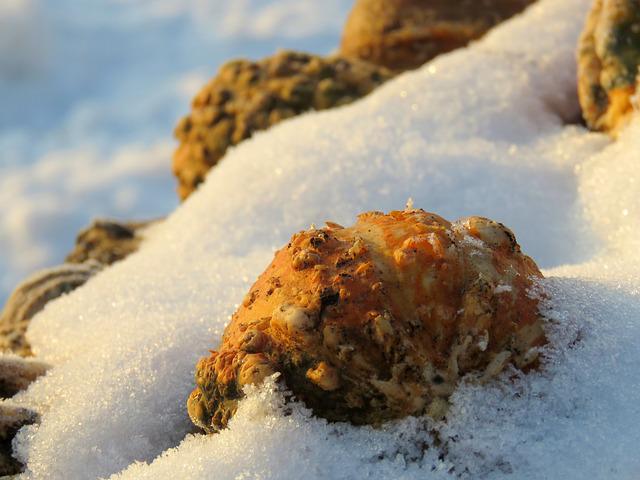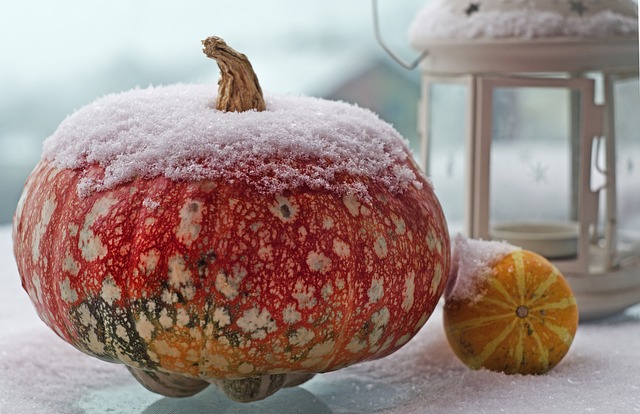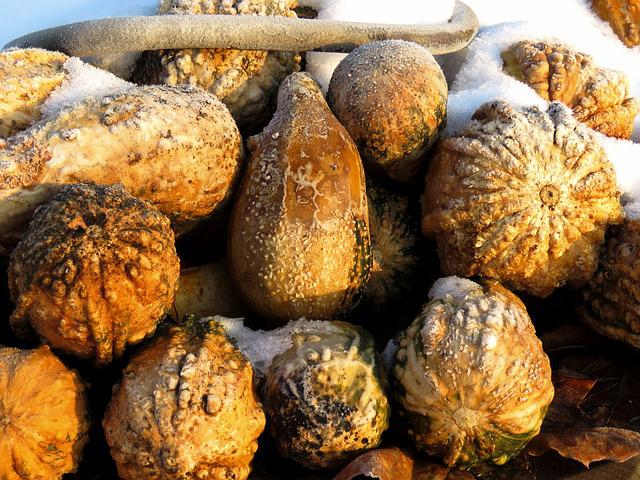Will Pumpkins Freeze if Left Outside?

It is generally acceptable to keep pumpkins in the garden until the ground freezes as long as it remains dry. Pumpkins and squash can be kept outside even if there is a chance of a light frost killing the leaves. Even though they can survive a light frost, it is best to protect them from the possibility of frost by covering them with a blanket made of fabric. Do not use plastic.
Table of Contents
Can Pumpkins Survive Frost?
While frost may kill pumpkins, it is not the end. Your pumpkin can probably weather a few touches of frost if you take a few important precautions. The most important thing to remember is that you need to keep your pumpkin warm and dry during extreme cold snaps. If it’s wet or cool inside the house, moisture will be drawn out of the pumpkin and likely wither.
With a Thin Layer of Frost
Your pumpkins should be fine if the frost isn’t too heavy. Frost is nothing more than frozen dew, and as soon as the sun shines on your garden, the frost is gone. This occurs when the temperature drops just below freezing. After a light frost, there is a chance of recovery.
Hard Frosty Nights
Your plants that aren’t hardy enough to withstand a frost will be killed if the temperature drops too low. According to Ruth Dobsevage’s blog, “Frost and the Fall Garden,” the frost harms plants because it freezes the water already present within the cells of the plants. This results in the death of the cells. After a severe frost, it is impossible to thaw out.
Temperature Tolerance of the Pumpkin Plants
Plant pumpkin seeds two weeks after the last expected frost have passed, when the soil temperature is at least 60°F (16°C), to avoid the negative effects of cold. Begin indoor seedlings two to four weeks before the last frost date in peat pots. Keep the temperature between 60-105°F (16°-41°C) to germinate and harden them before transplant.
Seedlings can be damaged or rotted if they are planted too early. At least 65 degrees Fahrenheit is the ideal temperature for transplanting. If temperatures drop below freezing in the spring or fall, protect pumpkins from frost or freezing by mulching them with black plastic or newspaper, growing them in a cold frame, or using row covers to trap heat.

What Happen to Pumpkins Damaged By Hard Frost?
If the frost or freeze was very bad, the vines are probably dead or very close to dying. Temperatures in the range of 28°F (-2°C) and lower will destroy the outside skin and tissue, and from there. The quality of the flesh will continue to deteriorate. When vines are damaged, they look dead and feel soft and mushy. The vines’ leaves and stems fall to the ground. Once pumpkins freeze, whether fully grown or still green, the fruit goes bad. Therefore, before a freeze, make sure that all pumpkins and squash have been picked.
In this case, you’ll have to figure out how to ripen any pumpkins that are still only partially orange on your own.
How to Protect Your Pumpkins from Frost
Ensure your pumpkins are properly clad in cloth or other insulation when you bring them into storage. If possible, try to store them outdoors in a protected area. You can use frost blankets, newspaper, or cardboard to cover your pumpkins.
A barrier of plastic can trap moisture. Instead of keeping the plants safe, this moisture will cause frost to form under the plastic.
When to Store
Early to late autumn is the best time to store winter squash and pumpkins. Allow the fruits to ripen on the plant for as long as possible, but before the first frost, to collect the most sugars from the leaves. To hasten to ripen, the foliage surrounding the fruit can be removed just before harvest.
It is best to harvest pumpkins while they are still green or partially green with some orange, preventing the skin from becoming damaged by frost.. If this occurs, pumpkins will no longer change color as they ripen. After being harvested, the pumpkin should be stored in a cool, dry location where it will not freeze. This will allow the pumpkin to finish the process of changing color, which is similar to what we do with tomatoes that are not quite ripe.
Recuperation Steps from Frost Damage
Conduct a thorough evaluation of the damages, examine the weather to determine how cold it was, etc. Only the pumpkin vines’ uppermost leaves were likely affected if the frost was not too severe. Begin by removing all dead objects. If you observe healthy leaves closer to the ground or near the fruit, you can anticipate some plant recovery; however, you should not expect miracles. This is the ideal circumstance. At this time, I recommend removing ripened pumpkins for storage, as this will allow the weakened vines to concentrate on the remaining unripe fruit. Leave green and partially green fruits on their vines.
As a general rule, if the temperature drops below 27 degrees, the weather is considered severe. If the damage is severe and it appears that the entire vine has been affected, you will need to harvest everything and attempt to ripen the partially orange ones using other methods. If the vine still possesses healthy leaves, it is still alive. While the pumpkins are still attached to their vines, carefully relocate them so that they receive as much direct sunlight as possible.
The sun’s light and warmth are your best ally to complete the ripening process. If the forecast calls for continued cold nights, you should cover your entire patch with plastic at night to keep as much heat near the vines and prevent frost from killing the remaining plants. Observe the situation daily and remove fruit as it ripens or becomes too cold to continue storing. At that point, harvest everything that remains and attempt to ripen them on your own.

